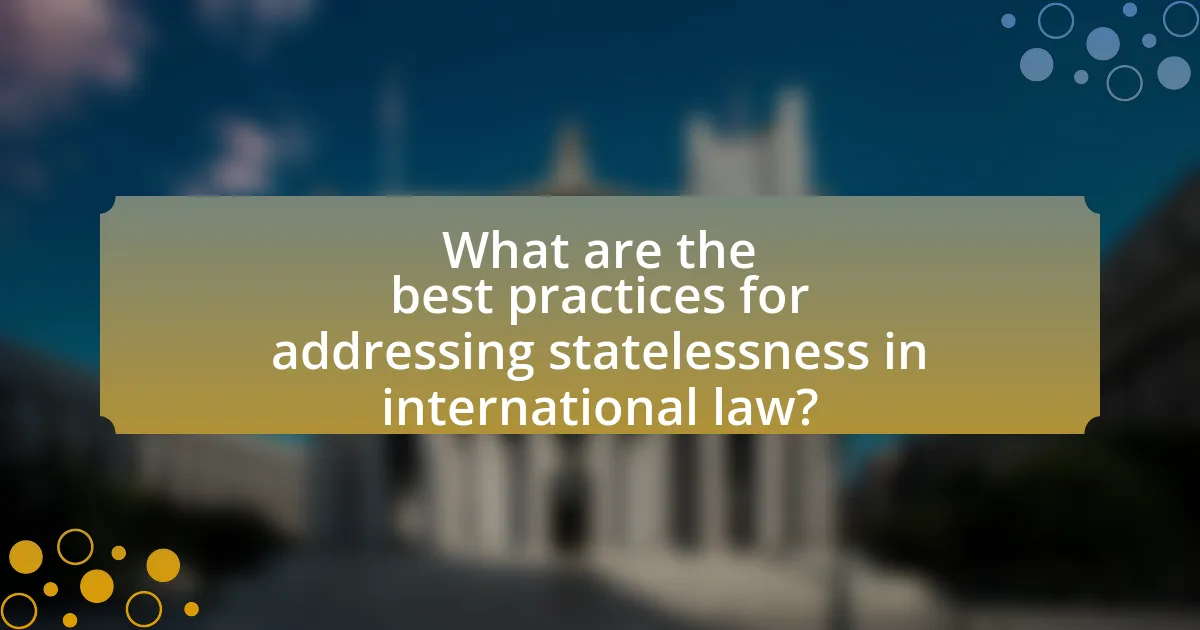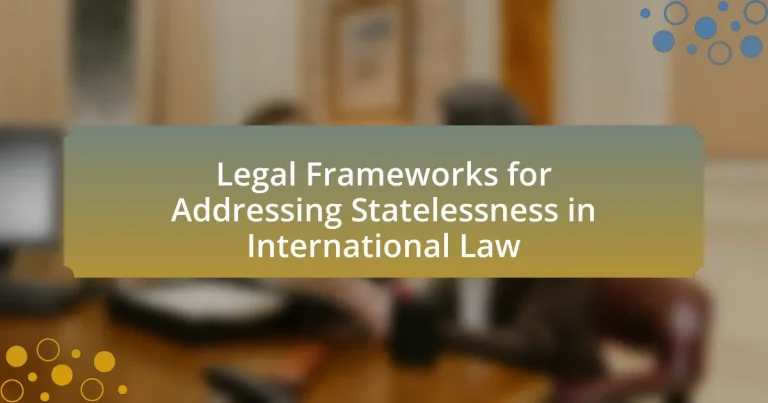The article focuses on the legal frameworks for addressing statelessness in international law, primarily highlighting the 1961 Convention on the Reduction of Statelessness and the 1954 Convention Relating to the Status of Stateless Persons. It outlines how these treaties establish principles for nationality laws, define statelessness, and protect the rights of stateless individuals. The article also discusses the role of international organizations, such as the UNHCR, in combating statelessness, the challenges in implementing legal frameworks, and the social implications of statelessness on individuals and communities. Additionally, it examines best practices for preventing statelessness and the importance of advocacy and partnerships in supporting stateless persons.

What are the Legal Frameworks for Addressing Statelessness in International Law?
The legal frameworks for addressing statelessness in international law primarily include the 1961 Convention on the Reduction of Statelessness and the 1954 Convention Relating to the Status of Stateless Persons. The 1961 Convention aims to prevent statelessness by establishing principles for nationality laws, requiring states to grant nationality to individuals born on their territory who would otherwise be stateless. The 1954 Convention provides a definition of stateless persons and outlines their rights, including access to education, employment, and legal assistance. These conventions are supported by various human rights instruments, such as the Universal Declaration of Human Rights, which emphasizes the right to nationality.
How do international treaties contribute to addressing statelessness?
International treaties contribute to addressing statelessness by establishing legal frameworks that protect the rights of individuals without nationality and promote their access to citizenship. For instance, the 1961 Convention on the Reduction of Statelessness obligates states to grant nationality to individuals born on their territory who would otherwise be stateless, thereby reducing the number of stateless persons. Additionally, the 1954 Convention Relating to the Status of Stateless Persons provides a definition of statelessness and outlines the rights of stateless individuals, ensuring they receive basic human rights and protections. These treaties create binding obligations for states, encouraging them to implement national laws and policies that prevent and reduce statelessness, ultimately fostering a more inclusive legal environment for affected individuals.
What are the key treaties related to statelessness?
The key treaties related to statelessness are the 1961 Convention on the Reduction of Statelessness and the 1954 Convention Relating to the Status of Stateless Persons. The 1961 Convention aims to prevent statelessness by establishing rules for nationality acquisition and retention, while the 1954 Convention provides a framework for the protection of stateless individuals, outlining their rights and the obligations of states. Both treaties are crucial in addressing the legal status and rights of stateless persons under international law.
How do these treaties define statelessness?
Treaties define statelessness as the condition of an individual who is not considered a national by any state under the operation of its law. The 1961 Convention on the Reduction of Statelessness specifies that a person is stateless if they do not possess the nationality of any country, while the 1954 Convention Relating to the Status of Stateless Persons outlines the rights of stateless individuals and the obligations of states to protect them. These definitions establish a legal framework that obligates states to prevent and reduce statelessness, ensuring that individuals without nationality are recognized and afforded certain rights.
What role do international organizations play in combating statelessness?
International organizations play a crucial role in combating statelessness by establishing legal frameworks, providing technical assistance, and facilitating international cooperation. Organizations such as the United Nations High Commissioner for Refugees (UNHCR) work to promote the 1961 Convention on the Reduction of Statelessness, which aims to prevent statelessness through nationality laws and policies. Additionally, the UNHCR conducts awareness campaigns and provides guidance to states on implementing effective nationality legislation, thereby reducing the number of stateless individuals. According to UNHCR reports, over 4.2 million people were identified as stateless in 2021, highlighting the ongoing need for international organizations to address this issue through advocacy and support for national governments.
How does the United Nations address statelessness?
The United Nations addresses statelessness through various initiatives, including the adoption of international treaties and the establishment of programs aimed at reducing and preventing statelessness. The 1961 Convention on the Reduction of Statelessness and the 1954 Convention Relating to the Status of Stateless Persons are key legal frameworks that guide member states in their obligations to prevent and reduce statelessness. Additionally, the UN High Commissioner for Refugees (UNHCR) leads efforts to identify stateless individuals, advocate for their rights, and promote solutions, such as nationality laws reform and birth registration initiatives. These actions are supported by the UN’s Global Action Plan to End Statelessness 2014-2024, which outlines specific goals and strategies for addressing the issue globally.
What initiatives have been launched by NGOs to support stateless individuals?
NGOs have launched various initiatives to support stateless individuals, including legal aid programs, advocacy for policy reforms, and awareness campaigns. For instance, organizations like the UNHCR and the Statelessness Network have implemented legal assistance projects that help stateless individuals navigate complex legal systems to obtain citizenship or legal status. Additionally, NGOs engage in advocacy efforts to influence national laws and policies, aiming to reduce statelessness through legislative changes. Awareness campaigns are also conducted to educate the public and policymakers about the plight of stateless individuals, highlighting the need for urgent action and support. These initiatives are crucial in addressing the challenges faced by stateless individuals and promoting their rights under international law.

What are the challenges in implementing legal frameworks for statelessness?
The challenges in implementing legal frameworks for statelessness include lack of political will, insufficient resources, and inadequate legal definitions. Many states are reluctant to recognize or address statelessness due to concerns about national security and immigration control, which hampers the adoption of comprehensive legal measures. Additionally, limited financial and human resources hinder the effective implementation of existing laws and policies aimed at reducing statelessness. Furthermore, ambiguous legal definitions of statelessness can lead to inconsistent application of laws, leaving many individuals without protection or access to citizenship. According to the UN High Commissioner for Refugees, over 4.2 million people are estimated to be stateless globally, highlighting the urgent need for effective legal frameworks and their implementation.
Why is enforcement of laws regarding statelessness difficult?
Enforcement of laws regarding statelessness is difficult due to the lack of political will among states to recognize and address the issue. Many countries prioritize national sovereignty and may resist international obligations that require them to grant nationality or protect stateless individuals. Additionally, the complexity of legal definitions surrounding statelessness, as outlined in the 1961 Convention on the Reduction of Statelessness, complicates the identification and protection of stateless persons. According to the United Nations High Commissioner for Refugees (UNHCR), an estimated 15 million people are stateless globally, highlighting the widespread nature of the problem and the challenges in implementing effective legal frameworks.
What are the barriers to effective enforcement of international treaties?
Barriers to effective enforcement of international treaties include lack of compliance mechanisms, insufficient political will among states, and varying interpretations of treaty obligations. Compliance mechanisms, such as monitoring and enforcement bodies, are often weak or non-existent, leading to inconsistent adherence to treaty terms. Political will is crucial; without it, states may prioritize national interests over international commitments, undermining treaty effectiveness. Additionally, differing interpretations of treaty language can result in disputes over obligations, complicating enforcement efforts. For instance, the United Nations Framework Convention on Climate Change faces challenges due to divergent national policies and priorities, illustrating how these barriers can hinder treaty enforcement.
How do national laws conflict with international frameworks?
National laws often conflict with international frameworks when domestic legislation fails to align with international treaties or conventions that a country has ratified. For instance, a nation may have laws that restrict citizenship based on ethnicity or religion, which contradicts the principles outlined in the 1961 Convention on the Reduction of Statelessness. This convention emphasizes the right to nationality and mandates that states provide a pathway to citizenship for individuals who would otherwise be stateless. Such discrepancies can lead to legal ambiguities and hinder the protection of stateless individuals, as national laws may prioritize local interests over international obligations.
What impact does statelessness have on individuals and communities?
Statelessness severely impacts individuals and communities by denying them basic rights and access to essential services. Individuals without nationality often face barriers to education, healthcare, and employment, leading to social and economic marginalization. For instance, the United Nations High Commissioner for Refugees (UNHCR) reports that stateless individuals are often unable to obtain legal documentation, which restricts their ability to travel, vote, or own property. Communities with high rates of statelessness experience increased vulnerability to exploitation and discrimination, as well as social instability due to the lack of legal recognition and protection for their members.
How does statelessness affect access to basic rights and services?
Statelessness severely restricts access to basic rights and services, as individuals without nationality often lack legal recognition and protection. This absence of citizenship leads to barriers in obtaining essential services such as healthcare, education, and employment. For instance, the United Nations High Commissioner for Refugees (UNHCR) reports that stateless individuals frequently face discrimination and exclusion from social services, which exacerbates their vulnerability. Additionally, without legal documentation, stateless persons cannot access legal employment or formal education, perpetuating cycles of poverty and marginalization.
What are the social implications of statelessness in affected communities?
Statelessness in affected communities leads to significant social implications, including marginalization, lack of access to basic services, and social instability. Individuals without nationality often face discrimination, limiting their ability to participate in society, which can result in increased poverty and social exclusion. For instance, a report by the United Nations High Commissioner for Refugees (UNHCR) indicates that stateless individuals frequently lack access to education, healthcare, and employment opportunities, exacerbating their vulnerability. Furthermore, the absence of legal recognition can foster social tensions and conflict, as stateless populations may be viewed as outsiders or burdens on the state, leading to further isolation and potential violence within communities.

What are the best practices for addressing statelessness in international law?
The best practices for addressing statelessness in international law include the adoption of comprehensive legal frameworks, the implementation of effective nationality laws, and the promotion of international cooperation. Comprehensive legal frameworks, such as the 1961 Convention on the Reduction of Statelessness, provide guidelines for states to prevent and reduce statelessness. Effective nationality laws ensure that individuals can acquire nationality at birth or through naturalization processes, thereby preventing gaps in citizenship. International cooperation, exemplified by initiatives from organizations like the United Nations High Commissioner for Refugees (UNHCR), facilitates the sharing of best practices and resources among states to address the issue collectively. These practices are supported by evidence indicating that countries with clear legal provisions and active engagement in international dialogues have successfully reduced instances of statelessness.
How can countries improve their legal frameworks to prevent statelessness?
Countries can improve their legal frameworks to prevent statelessness by enacting laws that guarantee nationality to individuals born on their territory, regardless of their parents’ nationality. This approach aligns with the principle of jus soli, which is recognized in international law, particularly in the Convention on the Reduction of Statelessness. Additionally, countries should ensure that their nationality laws are non-discriminatory, providing equal access to nationality for all individuals, including women and children, as mandated by the Convention on the Elimination of All Forms of Discrimination Against Women. Implementing these measures can significantly reduce the risk of statelessness, as evidenced by the successful reduction of stateless populations in countries that have adopted such legal reforms.
What measures can be taken to ensure birth registration for all?
To ensure birth registration for all, governments must implement universal birth registration policies that are accessible and inclusive. This can be achieved by establishing free and easily accessible registration services, particularly in remote or marginalized communities, and by raising public awareness about the importance of birth registration. According to UNICEF, as of 2021, approximately 166 million children under five years old remain unregistered globally, highlighting the need for targeted outreach and education campaigns. Additionally, integrating birth registration into health services, such as during maternal and child health programs, can facilitate the process and ensure that all births are recorded.
How can states harmonize their nationality laws with international standards?
States can harmonize their nationality laws with international standards by aligning their legal frameworks with the principles outlined in international treaties, such as the 1961 Convention on the Reduction of Statelessness and the 1954 Convention Relating to the Status of Stateless Persons. This alignment involves adopting provisions that ensure the right to nationality, preventing arbitrary deprivation of nationality, and recognizing the principle of non-discrimination. For instance, countries can implement measures that allow individuals to acquire nationality at birth, particularly for those born to stateless parents, thereby reducing the risk of statelessness. Additionally, states can establish clear procedures for nationality applications and appeals, ensuring transparency and accessibility, which is supported by the UN High Commissioner for Refugees’ guidelines on nationality and statelessness.
What role can civil society play in addressing statelessness?
Civil society plays a crucial role in addressing statelessness by advocating for the rights of stateless individuals and influencing policy changes. Organizations within civil society raise awareness about the plight of stateless persons, mobilize public support, and engage in legal advocacy to ensure that governments uphold international legal standards, such as the 1961 Convention on the Reduction of Statelessness. For instance, civil society groups have successfully lobbied for legislative reforms in various countries, leading to the recognition of citizenship rights for previously stateless populations, as seen in cases like the 2019 reforms in India that aimed to address statelessness among certain communities.
How can advocacy and awareness campaigns help reduce statelessness?
Advocacy and awareness campaigns can significantly reduce statelessness by educating the public and policymakers about the rights of stateless individuals and the legal frameworks that protect them. These campaigns raise awareness of the causes and consequences of statelessness, which can lead to increased political will to address the issue. For instance, the UN High Commissioner for Refugees (UNHCR) reports that targeted advocacy efforts have resulted in legislative changes in several countries, allowing individuals to acquire nationality and access essential services. By mobilizing communities and influencing government policies, advocacy campaigns create an environment conducive to the recognition and protection of stateless individuals, ultimately contributing to the reduction of statelessness globally.
What partnerships can be formed to support stateless individuals?
Partnerships that can be formed to support stateless individuals include collaborations between governments, non-governmental organizations (NGOs), international organizations, and civil society groups. These partnerships can facilitate the provision of legal assistance, advocacy for policy changes, and access to essential services such as healthcare and education. For instance, the United Nations High Commissioner for Refugees (UNHCR) works with various stakeholders to promote the rights of stateless individuals and to develop national action plans aimed at reducing statelessness. Additionally, local NGOs often partner with international bodies to implement community-based programs that address the specific needs of stateless populations, thereby enhancing their protection and integration into society.
What practical steps can individuals take to support stateless persons?
Individuals can support stateless persons by advocating for their rights and raising awareness about their plight. Advocacy can include engaging with local and international organizations that focus on statelessness, such as the United Nations High Commissioner for Refugees (UNHCR), which reports that there are over 4.2 million stateless individuals worldwide. Individuals can also volunteer their time or resources to organizations that provide legal assistance to stateless persons, helping them navigate complex legal systems to obtain citizenship or legal status. Additionally, individuals can participate in campaigns that push for policy changes at national and international levels, as effective legal frameworks are essential for addressing statelessness. By educating themselves and others about the issues faced by stateless persons, individuals can foster a more informed and compassionate community that supports the rights of these vulnerable populations.


